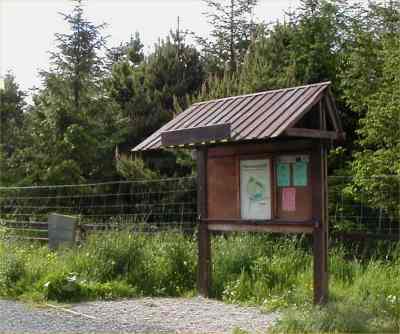|
NEWTONHILL COMMUNITY WOODLAND The Traill Lying 3km southwest of Wick, Newtonhill Community Woodland is a fine example of environmental restoration. Newtonhill was originally developed
as a stone quarry, and was later used as a rubbish dump. Owned by
the Highland Council, the site was planted with trees in the late 1970s,
and has been managed as a community woodland since 1996. the path through the woodland is a short trail of about 1km, and is suitable for all ages and levels of fitness. The start of the trail takes you into an area of mature conifers (mainly sitka spruce and lodgepole pine).The dark, moist conditions underneath create ideal growing conditions for many species of fungi, which appear from the leaf litter in autumn. See if you can find the distinctive ‘Shaggy Ink Cap’ with its egg-shaped cap and whitish shaggy fibres which, in time, will turn into a black liquid that looks like ink. Take a seat at the bench and listen – what do you hear? The woodland is a good place to listen to bird song. The trees, which are relatively
scarce in coastal Caithness, provide shelter for a variety of bird
species. Take a look at the row of sycamore
along the bridle path to your right. Do you see any movement amongst the
branches? Goldfinch, chaffinch and greenfinch come here often because of
the good seed supply. Following the path round on the left, you will leave the sheltered woodland into an area of open ground. This is an opportunity to spot moorland and wetland birds. Listen for the musical song of the high flying skylark and the highpitched, mechanical churring of the not-so-common grasshopper warbler. On the right lies an area of
wetland with willow and alder. Reeds, rushes and yellow flag iris were
planted Continue along the path and turn right onto the boardwalk, into the trees planted in the peatland area known as Newton Moss. The moorland here is dominated by ling heather and bog cotton, and has areas of soft peat where roe deer, fox and occasional otter tracks can be found. Take a look for tracks in the mud as you walk over the boardwalk. The central grassland part of the site contains many weed species, which came in with waste from people’s gardens. Flowering currant are good for bees, and the nettles and thistles attract butterflies such as the red admiral and small tortoiseshell. Look out for large stones, which thrushes use as anvils to smash open snail shells. You are approaching another area of wetland, where birch trees have been introduced in the clearing. The ditches and small ponds create good habitats for freshwater pond life. Look out for pond skaters gliding across the surface of the water and twirling whirligig beetles. At Newtonhill, new trees are often
planted to attract wildlife. The soil here is compacted, which makes it
hard for roots to develop. The area most recently planted was ‘mounded’,
where small areas of Take a rest at the picnic area. The dyke is similar to the traditional field boundary used around Caithness. It is made of flagstone - a type of rock very common in Caithness, which readily splits into large slices. The raised flower-beds are also made from Caithness flag. Once you reach the viewpoint, have a good look around you. Have you seen any of the species on the interpretation board? At this point, you are standing on an elevated viewpoint made from approximately 20 stacked and crushed cars - a reminder of the days when the site was used as a dump! For further information regarding the
woodland, please contact: |
 Newtonhill
Community Woodland
Newtonhill
Community Woodland